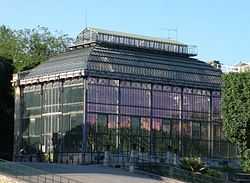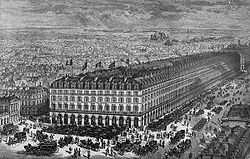Charles Rohault de Fleury
| Charles Rohault de Fleury | |
|---|---|
| Born |
22 September 1801 Paris, France |
| Died | 23 July 1875 (aged 73) |
| Nationality | French |
| Occupation | Architect |

Charles Rohault de Fleury (or Rohaut de Fleury; 22 September 1801 – 11 August 1875) was a French architect who designed many buildings in Paris, France, in the 19th century. In his later life he wrote a number of books on archaeological and religious subjects.
Early years
Charles Rohault de Fleury was born in Paris on 22 September 1801, son of the architect Charles Hubert Rohault de Fleury (1777–1846).[1] His uncle was Baron Hubert Rohault de Fleury, a distinguished military engineer.[2] He studied at the École Polytechnique in Paris, and graduated in 1822.[3] At first he studied sculpture, but then decided to take up architecture.[4] He became a pupil of his father, then studied under Louis-Hippolyte Lebas and at the École des Beaux-Arts. After completing his studies, in 1823 he was named inspector of barracks buildings for the Paris gendarmerie. In 1827 he won a prize for his design for the Lille courthouse.[3]
Career
In 1829 Rohault de Fleury and M. de Belleyme were commissioned to design a huge maison de refuge (shelter for the poor).[1] In 1832 Rohault de Fleury was named architect of the Museum of Natural History in Paris, replacing Jacques Molinos.[5] Between 1832 and 1838 he designed the Galerie de Minéralogie et de Géologie, the greenhouses and the monkey house.[6] His use of glass in what are now the Mexican and Australian hot-houses was highly innovative for the period.[7] In 1833 he was named architect of the several hospitals and hospices in Paris. He exhibited at the Salon in 1837.[6] In 1840 he made plans for an Italian opera house.[1]

Rohault de Fleury was part of the team led by Alfred Armand (1805–88) that designed the Grand Hôtel du Louvre, which opened in 1855 in time for the Exposition Universelle. The others were Jacques Ignace Hittorff (1793–1967) and Auguste Pellechet (1829–1903).[8] He built the Chambre des Notaires in 1857. He worked with Hittorff in 1857 and 1858 on plans for the buildings around the place de l'Étoile. He designed several other buildings including the Hippodrome, the old Opéra, the Stolikoff hotel on the rue Saint-Armand and the Casimir Périer hotel on the avenue Montaigne.[6]
Charles Rohault de Fleury was named Chevalier of the Legion of Honour in 1843, and became an officer on 1 January 1861.[6] His son Hubert Rohault de Fleury became a painter, and was instrumental in the erection of the Basilica of Sacré-Cœur, Paris.[9] His other son Georges Rohault de Fleury (1835–1904) was trained as architect but became an archaeologist and art historian.[10] After 1865 Charles Rohault de Fleury devoted himself to archaeological and religious studies with his son Georges, who arranged for publication of his works.[11]
Charles Rohault de Fleury died on 11 August 1875. His work on the jardin des plantes at the museum was published in folio in 1876 under the title Muséum d'histoire naturelle.[1] Some of his other works were published posthumously by his son George.[4]
Publications
Published works include:[11]
- de Fleury, Charles Rohault (1862). Manuel des lois du bâtiment. Paris: Société centrale des architectes.
- de Fleury, Charles Rohault (1866). Monuments de Pise au Moyen Âge. Paris.
- de Fleury, Charles Rohault (1870). Les instruments de la passion. Paris.
- de Fleury, Charles Rohault (1874). L'évangile, études iconographiques et archéologiques. 2 volumes. Paris.
- de Fleury, Charles Rohault (1874). La Toscane au Moyen Âge. Lettres sur l'architecture en 1400. Paris.
- de Fleury, Charles Rohault (1877). Le Latran au Moyen Âge. Paris.
- de Fleury, Charles Rohault (1879). La Sainte Vierge. 2 volumes. Paris. – Completed by his son George[12]
- de Fleury, Charles Rohault (1880). Le tabernacle chrétien du 5ème siècle. Arras.
- de Fleury, Charles Rohault (1889). Archéologie chrétienne. 8 volumes. Paris: Librairies-imprimeries réunies.
- de Fleury, Charles Rohault (1898). La Messe, études archéologiques sur ses monuments. Paris.
References
Citations
- ↑ 1.0 1.1 1.2 1.3 de la Chavignerie & Auvray 1885, p. 408.
- ↑ Zanten 1987, p. 120.
- ↑ 3.0 3.1 Bauchal 1887, p. 719.
- ↑ 4.0 4.1 Weber 1912.
- ↑ Bauchal 1887, p. 719-720.
- ↑ 6.0 6.1 6.2 6.3 Bauchal 1887, p. 720.
- ↑ Jardin des Plantes: Paris Walking Tours.
- ↑ Vajda 2008, pp. 27–44.
- ↑ Benoist 1992, p. 62.
- ↑ Willesme 2010, p. 2.
- ↑ 11.0 11.1 Charles Rohault de Fleury: Structurae.
- ↑ Willesme 2010, p. 3.
Sources
- Bauchal, Charles (1887). "Rohaut de Fleury (Charles)". Nouveau dictionnaire biographique et critique des architects franc̜ais. André, Daly fils. Retrieved 2014-02-09.
- Benoist, Jacques (1992). Le Sacré-Coeur de Montmartre. Editions de l'Atelier. ISBN 978-2-7082-2978-5. Retrieved 2014-02-10.
- "Charles Rohault de Fleury". Structurae. Retrieved 2014-02-09.
- de la Chavignerie, Émile Bellier; Auvray, Louis (1885). Dictionnaire général des artistes de l'école française, continué par L. Auvray. Retrieved 2014-02-09.
- "Jardin des Plantes". Paris Walking Tours. Retrieved 2014-02-09.
- Vajda, Joanne (2008). "Les Pereire et les Nalgelmackers, promoteurs du transport ferroviaire et du réseau hôtelier parisien, 1855–1900". Revue d’histoire des chemins de fer (38). ISSN 0996-9403. Retrieved 2014-02-08.
- Weber, Nicholas (1912). "Rohault de Fleury". The Catholic Encyclopedia 13. New York: Robert Appleton Company. Retrieved 2014-02-10.
- Willesme, Jean-Pierre (16 April 2010). "Rohault de Fleury, Georges" (PDF). Institut national d’histoire de l'art. Retrieved 2014-02-09.
- Zanten, David Van (1987). Designing Paris: the architecture of Duban, Labrouste, Duc, and Vaudoyer. MIT Press. ISBN 978-0-262-22031-6.
|
